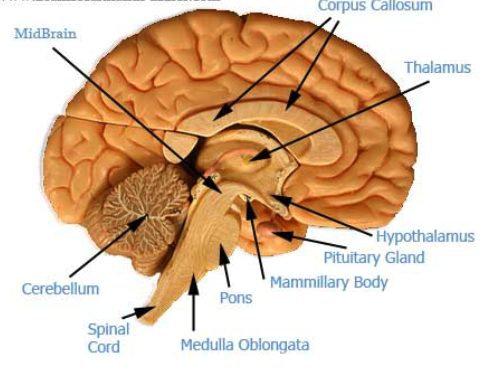Biological Bases of Behaviour
1/127
Earn XP
Description and Tags
Ngl this unit was one of the hardest units for me along with developmental psychology. This chapter is also so long so like suffer with me.
Name | Mastery | Learn | Test | Matching | Spaced |
|---|
No study sessions yet.
128 Terms
Nature-nurture issue
The longstanding controversy over the relative contributions that genes and experience make to the development of psychological traits and behaviors.
Basically, do genetics or environment contribute to psychology more?
Today's science sees traits and behaviors arising from the interaction of nature and nurture
Everything psychological is simultaneously biological
Natural Selection
The principle that inherited traits that better enable an organism to survive and reproduce in a particular environment will (in competition with other trait variations) most likely be passed on to succeeding generations
Darwin proposes that nature selects the genetic variations which help us to pass on our genes and survive in our environments
Many predisposed behavioural patterns are no longer aligned with survivability and fitness today
Mutation
A random error in gene replication that leads to a change
Evolutionary psychology
The study of the evolution of behavior and the mind, using principles of natural selection
Helps us understand human behaviour and mental processes
Can help explain some behaviour but are not as restrictive in humans as other species
Genes and environment both interact and contribute to our fitness - our ability to survive and reproduce
Behaviour genetics
The study of the relative power and limits of genetic and environmental influences on behaviour
Environment
Every non-genetic influence, from prenatal nutrition to the people and things around us
Heredity
The genetic transfer of characteristics from parents to offspring
Behaviour geneticists
Focus on how genes and the environment contribute to differences in behaviour and mental processes
Main questions is how much of who we are is a product of heredity or of our environment
Environmental influences are external; Heredity is internal.
Genes
The biochemical units of heredity that make up the chromosomes; a segment of DNA capable of synthesizing a protein
In normal development, humans receive 23 chromosomes from each parent
Each chromosome is made of DNA, which is made up of genes
Genes are also influenced by the environment
Genome
The complete instructions for making an organism, consisting of all the genetic material in that organism's chromosomes
Small variations can do big changes, like how every race of people are 95% similar
Identical (monozygotic) twins
individuals who developed from a single fertilized egg that split in two, creating two genetically identical organisms
DNA is exactly the same as each other
Fraternal (Dizygotic) twins
Individuals who developed from separate fertilized eggs. They are genetically no closer than ordinary siblings, but shared a prenatal environment.
No more genetically related than regular siblings
(Separated) twin studies
Used by researchers to point out the similarities in identical twins raised in different environments
While genes influence personality traits (extrovert, introvert, etc), environment influences attitudes, values, manners, faith, and politics
Adopted twins' personalities are more like their biological parents rather than their adoptive ones
Interaction
The interplay that occurs when the effect of one factor (such as environment) depends on another factor (such as heredity)
A main topic of modern psychological research
Differences can result from environment but connects to adaptation
Gene-environment interaction investigates a variety of topics including mental and physical health issues
Epigenetics
"above" or "in addition to" (epi) genetics; the study of the molecular mechanisms by which environments can influence genetic expression (without a DNA change).
How heredity and environment work together
Environments can trigger or block genetic expression.
Genetic markers direct genes to be 'turned off or on'; these markers are influenced by environmental factors such as diet, stress, and drug use.
Childhood trauma, poverty, and stress from war may have long lasting effects on a person's genes.
Bottom line: Nature via nurture
Nervous system
The body's speedy, electrochemical communication network, consisting of all the nerve cells of the peripheral and central nervous systems
Whole body communicates with itself
Nervous system is made up of neurons that use neurotransmitters to communicate between areas
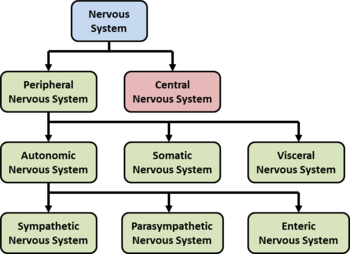
Neurons
A nerve cell; the basic building block of the nervous system
Send messages, process information, make decisions, and send signals to execute commands throughout the body
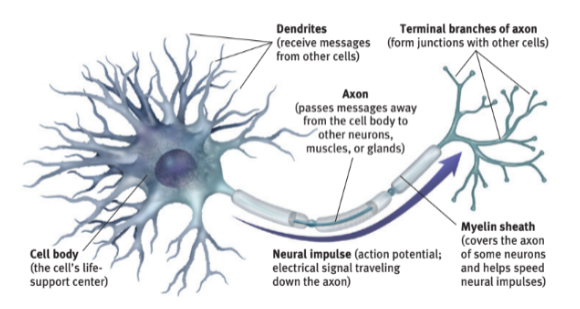
Central Nervous System (CNS)
Consists of the brain and spinal cord
Thinking, feeling, and acting must all be routed through the CNS, through millions and millions of neurons communicating with each other
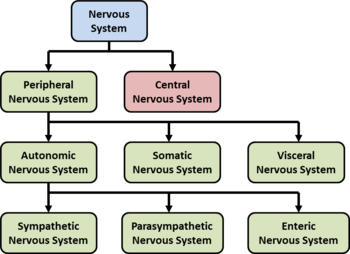
Peripheral Nervous System (PNS)
The sensory and motor neurons that connect the central nervous system (CNS) to the rest of the body.
Helps the CNS to communicated with the rest of the body by transmitting sensory information to the brain and delivering commands to muscles and glands
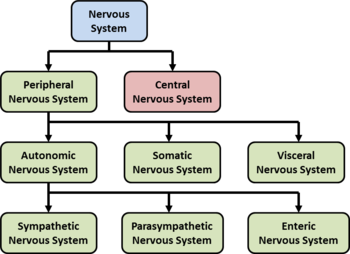
Nerves
Bundled axons that form neural "cables" connecting the central nervous system with muscles, glands, and sensory organs
Sensory (Afferent) neurons
Neurons that carry incoming information from the body's tissues and sensory receptors to the brain and spinal cord
SAME
Sensory Afferent, Motor Efferent
Bring messages from the sensory receptors to the CNS for processing
Motor (Efferent) neurons
Neurons that carry outgoing information from the brain and spinal cord to the muscles and glands
Carry commands of response back out to the muscles and glands of the body to act in response to stimuli
SAME
Sensory Afferent, Motor Efferent
Interneurons
Neurons within the brain and spinal cord that communicate internally and intervene between the sensory inputs and motor outputs (connect afferent and efferent neurons)
Process all incoming information and then make decisions about what responses would be appropriate
Millions of Afferent and Efferent neurons but billions of these
Somatic (skeletal) nervous system
Enables communication from the brain and spinal cord to our muscles connected to bones. Responses are carried out by this part of the PNS by motor neurons

Autonomic nervous system
Controls self-regulated action of internal organs and glands
Is further divided into 2 divisions
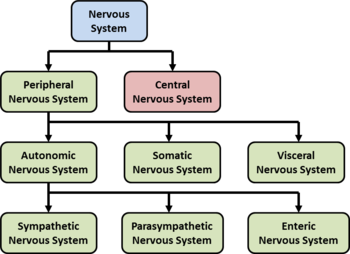
Sympathetic nervous system
Arouses the body, prepares it for fight or flight at a time when there may be danger
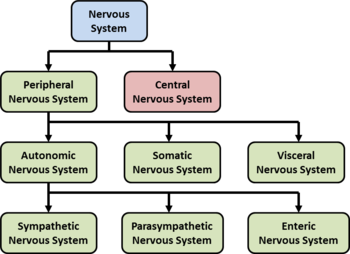
Parasympathetic nervous system
Calms the body down and brings it back to a normal resting state after an arousal producing event has passed
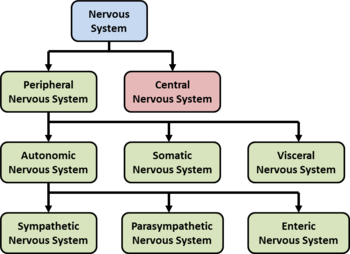
Neural networks
Clusters of neurons that layer together to work on connected tasks
Neurons that are constantly in communication with each other become stronger in their connections
Reflex
Simple, automatic response to a sensory stimulus such as the knee-jerk reflex
Spinal cord
Connects the peripheral nervous system to the brain and facilitates communication between the two. It also processes reflexes independently of the brain.
Reflex Arc
The neural pathway that mediates a reflex action, involving sensory neurons, interneurons, and motor neurons.
Cell Body
The part of a neuron that contains the nucleus; the cell’s life support system. It integrates incoming signals and generates outgoing signals to the axon.
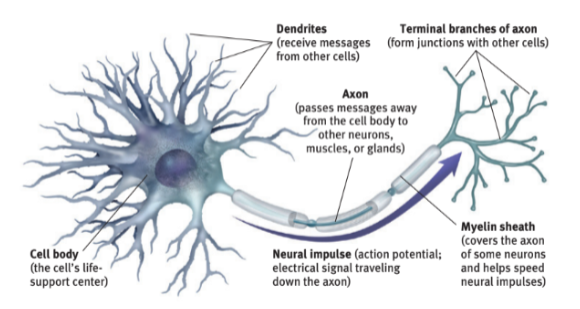
Dendrites
Neuron’s bushy branching extensions that receive and integrate messages, conducting impulses towards the cell body and plays a crucial role in neuronal communication.
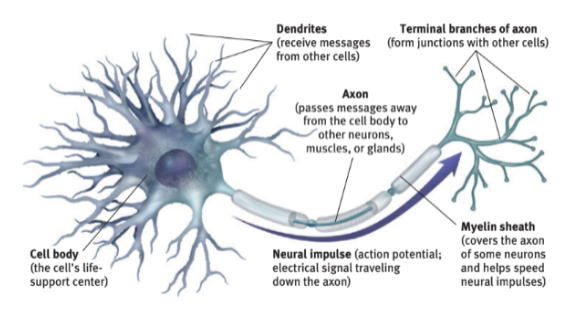
Axon
The segmented neuron extension that passes messages through its branches to other neurons or to muscles or glands. It is responsible for transmitting electrical impulses away from the cell body and can be covered by myelin sheath to enhance signal speed.
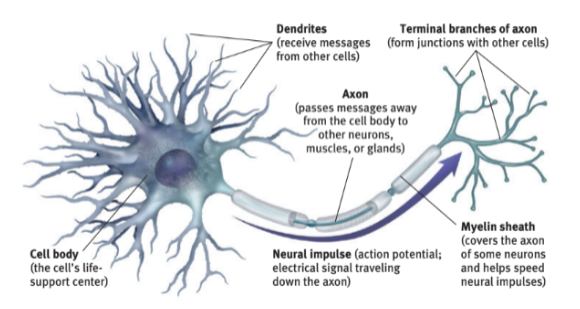
Myelin Sheath
A fatty tissue layer segmentally encasing the axons of some neurons; it enables vastly greater transmission speed as neural impulses hop from one node to the next
However, after the age of 25, myelin starts to degenerate, which leads to slower reaction time.
Multiple sclerosis has been linked to extreme deterioration
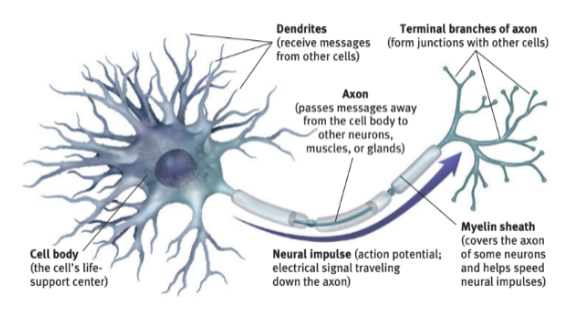
Glial cells
Cells in the nervous system that support, nourish, and protect neurons
Also play a role in learning, thinking, and memory
Serve neurons by feeding them, creating myelin for insulation, guiding connections, and cleaning up the environment in which neurons live
Action potential
A neural impules or a brief electrical charge that travels down an axon.
They are the means of communication between neurons
A brief electrical charge is rushed down the axon by opening a series of gates that allow positive ions to rush in and create depolarisation
Neuron will fire action potential if excitatory impulses outnumber inhibitory ones.
After firing, every neuron must rest during a refractory period before it fires again
Threshold
The level of stimulation required to trigger a neural impulse; it is the point at which a neuron will fire an action potential.
Refractory period
A brief resting pause that occurs after a neuron has fired; subsequent action potentials cannot occur until the axon returns to its resting state
All or none response
A neuron’s reaction of either firing with a full strength response or not firing. No in-between
Synapse
The junction between the axon tip of the sending neuron and the dendrite or cell body of the receiving neuron.
The tiny gap of this junction is called the synaptic gap or synaptic cleft
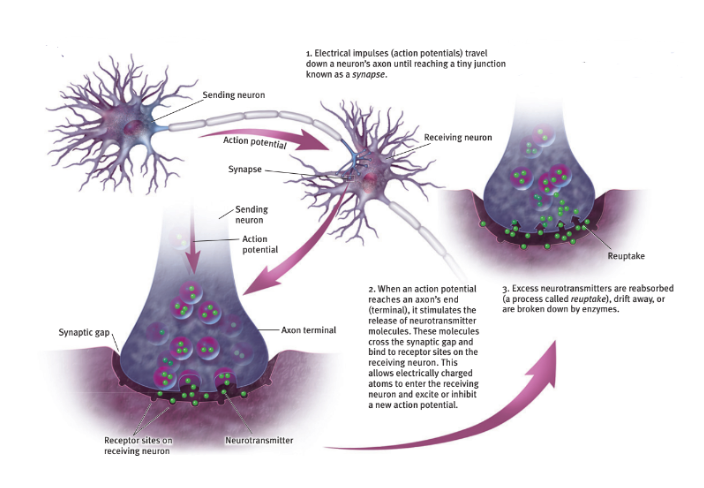
Neurotransmitters
Chemical messengers that cross the synaptic gap between neurons
When released by the sending neuron, they travel across the synapse and bind to receptor sites on the receiving neuron which influences whether or not the neuron will generate a neural impulse
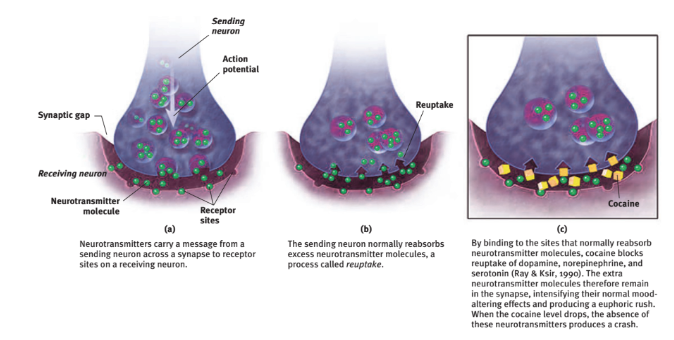
Reuptake
A neurotransmitter’s reabsorption by the sending neuron
Endorphins
“Morphine within”; natural opioid-like neurotransmitters linked to pain control and pleasure
Also released when we partake in vigorous exercise
Acetylcholine (ACh)
Best known to influence learning, memory, and muscle action
Agonist
A molecule that increases a neurotransmitter’s actions
Mimic a neurotransmitter, blocks reuptake, and/or increases production
Antagonist
A molecule that inhibits or blocks a neurotransmitter’s actions
Block receptor sites, decrease production, and release neurotransmitters
Endocrine system
The body’s “slow” chemical communication system; a set of glands and fat tissue that secrete hormones into the bloodstream
Body’s second system of communication that uses hormones instead of neurotransmitters to influence behaviour and emotions
Some hormones are identical to neurotransmitters, but travel through the body at slower speeds
Autonomic nervous system controls the adrenal glands
KING GLAND IS THE PITUITARY GLAND THAT CONTROLS AND INFLUENCES ALL OTHER GLANDS!!!
Hormones
Chemical messengers that are manufactured by the endocrine glands, travel through the bloodstream, and affect other tissues
Epinephrine/Norepinephrine
Fight or flight response - released by adrenal glands
Psychoactive drug
Chemical substance that alters the brain, causing changes in perceptions and moods
Used by many daily like caffeine, alcohol, and nicotine
Substance use disorder
Disorder characterised by continued substance use despite life disruption
Tolerance
Diminishing effect with regular use of the same dose of drug
Will require the user to take larger and larger doses before experiencing the drug’s effect
Addiction
An everyday term for compulsive substance abuse that continue despite harmful consequences
Withdrawal
Discomfort and distress that follow discontinuing an addictive drug or behaviour
Stimulants
Drugs that excite neural activity and speed up body functions
Caffeine is a commonly used stimulant
Nicotine is also delivered through cigarettes and vaping products and is a lead cause of preventable death (7 million casualties annually) it also corresponds to depression and chronic disability
Cocaine is also highly addictive and is smoked, snorted, or injected, which causes a rush of euphoria. It results in increased aggression, inflated confidence, emotional disturbances, and cardiac arrest
Depressants
Drugs that reduce neural activity and slow body functions
Alcohol is a commonly used depressant
Memory disruptions and less REM sleep are also depressing effects of alcohol
Barbiturates
Drugs that depress central nervous system activity, reducing anxiety but impairing memory and judgement
Alcohol and barbiturates combined are deadly
Overdoses are common
Opioids
Opium and its derivatives; depress neural activity, temporarily lessening pain and anxiety
Examples: heroin, oxycontin, morphine, and fentanyl
Hallucinogens
Psychedelic (“mind manifesting”) drugs distort perceptions and evoke sensory images in the absence of sensory input
They tend to follow patterns where they are provoked by drugs, loss of oxygen, or even a near-death experience
Can be synthetic like LSD and MDMA or organic like psilocybin or ayahuasca
Can be used to treat PTSD disorders
Marijuana contains THC and produces a mix of effects, but can be used in medicinal purposes
Near-death experience
Altered state of consciousness reported after close brushes with death; similar to drug-induced hallucinogens
Picture of substances in case y’all are confused

Biological psychology
The scientific study of the links between biological (genetic, neural, hormonal) and psychological processes
History:
Hippocrates correctly located the mind in the brain
Franz Gall incorrectly believed that the outside of the skull with its cavities were connected to function - he did reveal that the brain functions are regionalised but on the inside, not on the outside
Biopsychosocial approach
An integrated approach that incorporates biological, psychological, and social-cultural levels of analysis
Each biological system is part of a subsystem that makes up the whole person who in turn lives within family, community, and culture

Levels of analysis
The differing complementary views, from biological to psychological to social-cultural, for analysing any given phenomenon
Neuroplasticity
The brain’s ability to change, especially during childhood, by reorganising after damage or by building new pathways based on experience
Practice of information or skills can lead to changes in the brain associated with habitual tasks
Part of what makes humans exceptional at adapting to a constantly changing world
Lesion
Tissue destruction
Brain lesions use the brain’s ability to change, especially during childhood, by reorganising after damage or by building new pathways based on experience
Parts of the brains can be stimulated or lesioned in order to observe effects
EEG (electroencephalogram)
An amplified recording of the waves of electrical activity sweeping across the brain’s surface.
These waves are measured by electrodes placed on the scalp
Shows electrical activity patterns of a brain at work
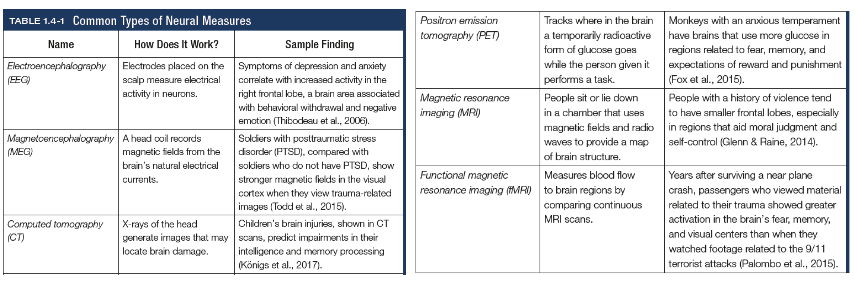
MEG (magnetoencephalography)
A brain imaging technique that measures magnetic fields from the brain’s neural activity
Isolates magnetic fields generated by the brain during tasks and can show how this task affects brain activity
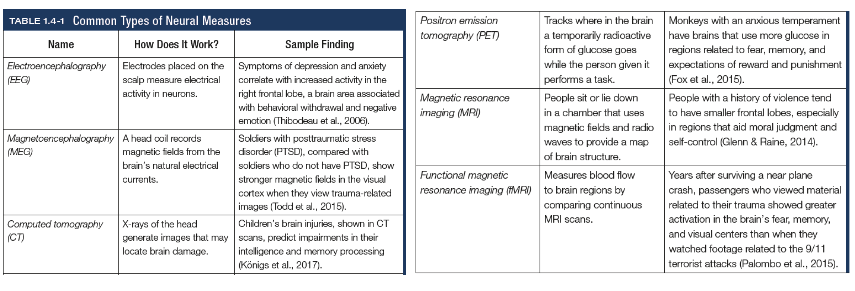
CT (computed tomotography) scan
A series of X-ray photographs taken from different angles and combined by computer into a composite representation of a slice of the brain’s structure
Shows structural damage such as after a brain injury
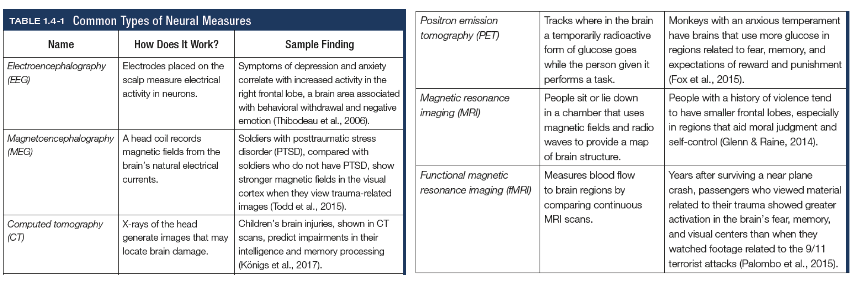
PET (Positron emission tomography)
A technique for detecting brain activity that displays where a radioactive form of glucose goes while the brain performs a given task
Following radioactive glucose trackers to identify active areas of the brain

MRI (magnetic resonance imaging)
Technique that uses magnetic fields and radio waves to produce computer generated images of soft tissue (shows brain anatomy)
No radiation
Can also identify enlarged or damaged areas of the brain
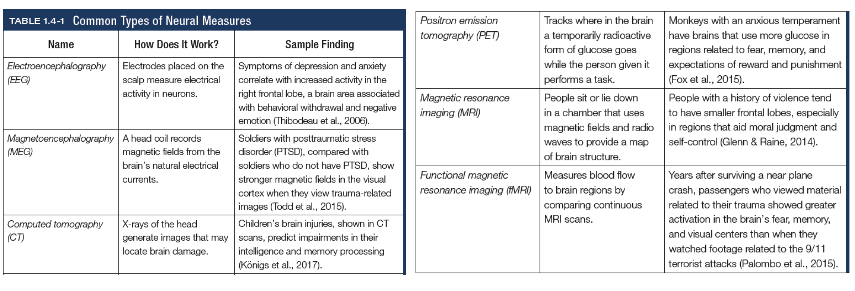
fMRI (functional MRI)
A technique for revealing blood flow and therefore brain activity by comparing successive MRI scans
Shows brain anatomy AS WELL AS structure
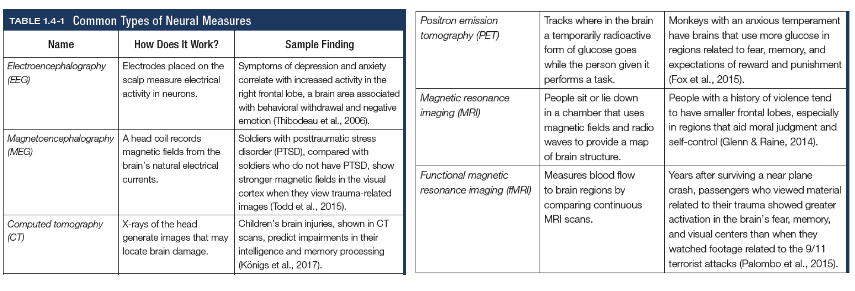
Hindbrain
Consists of the medulla, pons, and cerebellum
Directs essential survival functions such as breathing, sleeping, and wakefulness, as well as coordination and balance.
Midbrain
Found atop the brainstem
Connects the hindbrain with the forebrain
Controls some motor movement, and transmits auditory and visual information
Forebrain
Consists of the cerebral cortex, thalamus, and hypothalamus
Manages complex cognitive activities, sensory and associative functions, and voluntary movements
Brainstem
The central core of the brain, beginning where the spinal cord swells as it enters the skull
The brainstem is responsible for automatic survival functions
Most nerves crossover in the brainstem to connect with the opposite side of the body
Medulla
The hindbrain structure that is the brainstem’s base
Controls heartbeat and breathing
Pons
Sits right above the medulla
Helps coordinate movements and control sleep
Thalamus
The forebrain’s sensory control centre, located on top of the brainstem
It directs messages to the sensory receiving areas in the cortex and transmits replies to the cerebellum and medulla
Routes all sensory information EXCEPT SMELL to the appropriate processing centres in the forebrain
Reticular formation
A nerve network that travels through the brainstem into the thalamus
It filters information and plays a role in controlling arousal and state of alertness
Cerebellum
The hindbrain’s “little brain” at the rear of the brainstem
Control procedural memories of skills and nonverbal learning
It also controls balance and coordination of movements along with the pons
Its functions include processing sensory input, coordinating movement output and balance, and enabling nonverbal learning and memory
Limbic system
Neural system located mostly in the forebrain below cerebral hemispheres that includes the amygdala, hypothalamus, and hippocampus
Associated with emotions and drives
Amygdala
2 lima bean sized neural clusters in the limbic system that is linked to emotion
Enables fear and aggression, however many other areas are also active during these emotions so there are other parts of the brain controlling it as well
Hypothalamus
A limbic system neural structure lying below (hypo) the thalamus
It directs several maintenance/homeostasis activities (eating, drinking, body temperature), helps govern the endocrine system and is linked to emotion and reward
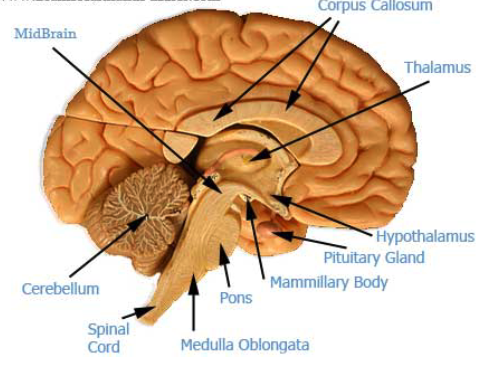
Hippocampus
A neural centre in the limbic system that helps process explicit (conscious) memories of facts and events for storage
Declines with age
Cerebral Cortex
The intricate fabric of interconnected neural cells covering the forebrain’s cerebral hemisphere
Cerebrum
Largest part of brain
The body’s ultimate control and information processing centre
2 Hemispheres covered in a thin layer called the cerebral cortex which contains billions of interconnected neurons
Each hemisphere divided into 4 lobes, with each having a left and right side
Frontal lobes
The portion of the cerebral cortex lying behind the forehead
It is involved in speaking and muscle movements and in making plans and judgements
Are the last to fully develop in adults, which determines mental maturity
Parietal lobes
The portion of the cerebral cortex lying at the top of the head and toward the rear
Receives sensory input for touch and body position (kinesthetics)
Linked to mathematical and spatial reasoning
Occipital lobes
The portion of the cerebral cortex lying at the top of the head and toward the rear
Receives sensory input for touch and body position, as well as vision
Temporal lobe
The portion of the cerebral cortex lying roughly above the ears
Includes the auditory areas, each of which receives information primarily from the opposite ear
Contains auditory cortex
Motor cortex
A cerebral cortex area at the rear of the frontal lobes that controls voluntary movements
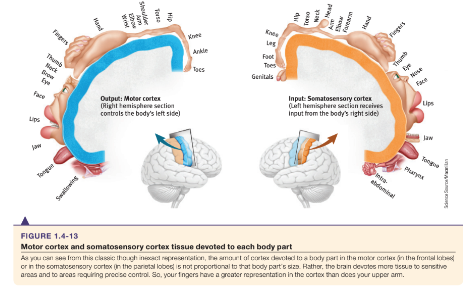
Somatosensory cortex
A cerebral cortex area at the front of the parietal lobes that registers and processes body touch and movement sensations
Similar in functioning to motor cortex
More cortical space is connected to areas of the body capable of more complex movements
Receives information from the skin, senses, and movement of body parts
More sensitive areas of the body are given larger amounts of cortical space in the sensory cortex
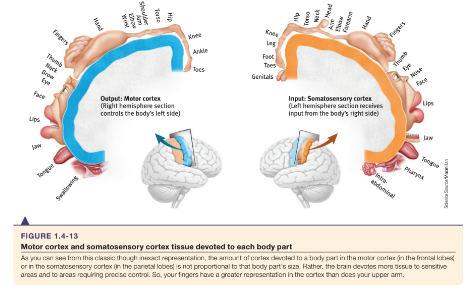
Association areas
Areas of the cerebral cortex that are not involved in primary motor or sensory functions, but rather in higher mental functions such as learning, remembering, thinking, and speaking
Connected to facial recognition
Prefrontal cortex
Located in the frontal lobe
Responsible for planning, judgement, and social interactions
Phineas Gage’s frontal lobe was severed and his emotional regulation was compromised
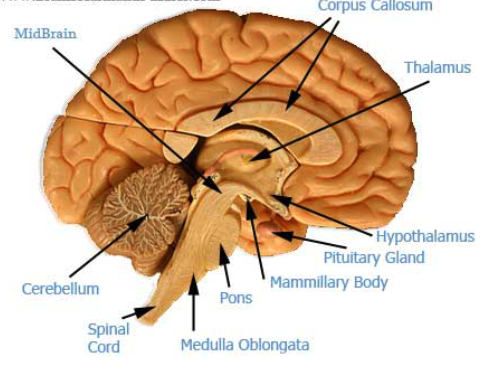
Neurogenesis
The formation of new neurons
Severely injured areas of the spinal cord or brain cannot regenerate nor repair fully, but some reorganisation can occur in young children
Neuroplasticity
The brain’s ability to reorganise and restore some functioning after damage or due to disability
Sensory disabilities often result in increased functioning in other parts of the brain
Corpus Callosum
The large band of neural fibres connecting the 2 brain hemispheres and carrying/relaying messages between them
